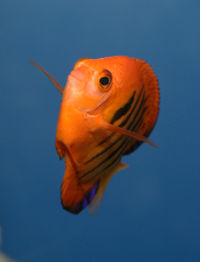Difference between revisions of "Centropyge loricula"
From The Aquarium Wiki
(→External links) |
|||
| Line 85: | Line 85: | ||
*[http://www.fishkeeping.co.uk/modules/caresheets/caresheet.php?caresheetID=15 Fishkeeping.co.uk] | *[http://www.fishkeeping.co.uk/modules/caresheets/caresheet.php?caresheetID=15 Fishkeeping.co.uk] | ||
*[http://www.liveaquaria.com/product/prod_display.cfm?c=15+16+444&pcatid=444 Live Aquaria] | *[http://www.liveaquaria.com/product/prod_display.cfm?c=15+16+444&pcatid=444 Live Aquaria] | ||
| + | *[https://connectfishfriends.com/livestock-details/flame-angelfish Connect Fish Friends] | ||
Latest revision as of 00:17, 26 October 2023
Flame Angel
Centropyge loricula
151 Litres (40 US G.)
12-15 cm (4.7-5.9")
8.0 - 8.5
23.9-26.7°C (75 -80 °F)
8-10 °d
1:1 M:F
2->20 years
Family
Pomacanthidae
Contents
Additional names
- Flame Angel, Dwarf Flame Angel, Flame Angelfish
Additional scientific names
- Centropyge loriculus
Origin[edit]
- Pacific Ocean; mainly tropical water.
Sexing[edit]
- Males are larger and brighter in colour.
Tank compatibility[edit]
- A relatively peaceful fish suitable for peaceful communities and is considered reef safe, although may nip at stony corals, zoanthids and some clams. Best kept either singly or in pairs however. Two males are not advised and should not be kept with similar-looking fish.
Diet[edit]
- The Flame Angel prefers a varied diet of spirulina and marine algae as well as mysid shrimp and other prepared meaty foods.
Feeding regime[edit]
- Feed once or twice a day.
Environment specifics[edit]
- Prefers a spacious tank with plenty of live rock and hiding places. Needs an SG of 1.020 - 1.023.
Behaviour[edit]
- Generally peaceful towards tank mates, but may be territorial to new additions, other Flame Angels or similar looking fish.
Identification[edit]
- This fish has a vivid oval-shaped orange body and fins. The anal and dorsal are tipped with vivid blue and the flanks are striped with vertical black bars.
Notes[edit]
The flame angelfish commonly sold come from Christmas/Marshall islands. There is a deep sea variety actually native to Hawai'i, which is rare due to its deep sea habitat. The hawai'ian variety is redder than the other variety.
Pictures[edit]
External links[edit]
- Fishbase (Mirrors:
 )
)

